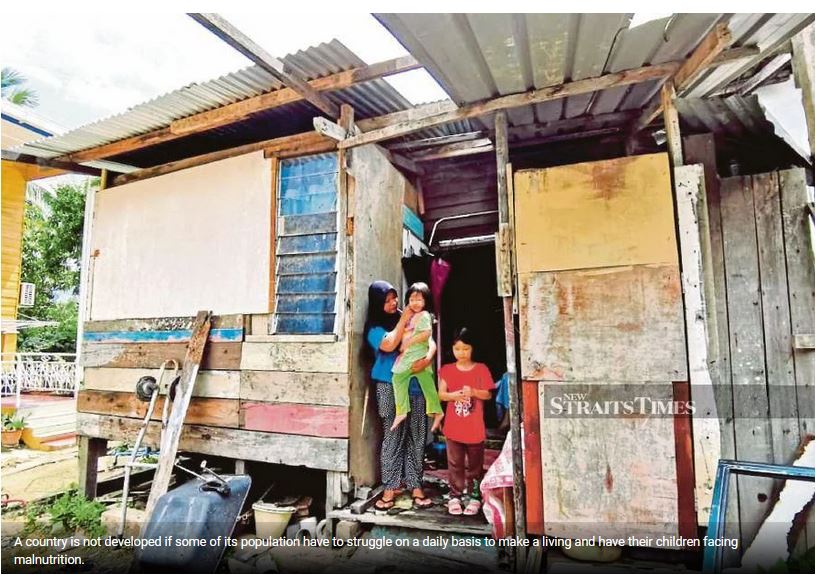Role of Sejahtera in eliminating poverty
Emeritus Professor Tan Sri Dato' Dzulkifli Abdul Razak
Opinion - New Straits Times
October 18, 2019
THE International Day for the Eradication of Poverty falls on Oct 17 every year. We acknowledged it this time through an international conference in Kuala Lumpur attended by Prime Minister Tun Dr Mahathir Mohamad.
The theme was “Inclusive Development and Sejahtera in the New Malaysia”, linking for the first time “sejahtera” and “eradication of poverty” in the context of Sustainable Development Goals (SDGs 2016-2030). The SDGs embrace 17 goals, and the very first one is the goal of “No Poverty”.
This makes it even more meaningful as the event was hosted by Yayasan Sejahtera, in conjunction with its 10th anniversary. For the last decade, Yayasan Sejahtera has been using a community-based approach to resolve numerous community issues involving some 12,000 people by adopting a bottom-up approach, funded by the private sector as part of corporate social responsibility.
This is markedly different from the conventional way of top-down government-funded mechanism that has become questionable of late. Not only has effectiveness been the subject of intense query — not ruling out corruption — but equally important it is about empowering the people to seek their own solutions which are often within their grasp once they are empowered. Thus the funding equation is better handled and goes a long way in finding a “solution” to real issues in real life.
These perhaps are just some of the salient points that Yayasan Sejahtera was able to showcase over the last decade in engaging many villages in some of the remotest parts of the country. Believe it or not, some are still without a reliable source of potable water — in one case, over the last 40 years.
Some have no reliable electricity supply even though there are signboards that (falsely) read “intenet tanpa wayar” at the very entrance of the villages. Sadder still when schoolchildren have to walk long distances, crossing many rivers before arriving at school supposedly ready to learn if their energy is not sapped away.
However, according to the prime minister, in his keynote address, our experience has taught us that economic growth per se does not equate with development for all. He said a country cannot consider itself developed if there are some segments of society which do not have access to basic amenities, do not have jobs that can give them sufficient incomes or are unemployed, and have little access to productive assets.
In addition, a country is also not developed if some of its population have to struggle on a daily basis to make a living and their children face malnutrition. Shortfalls in the attainment of the SDGs have to be rapidly addressed failing which Malaysia’s aspirations to join the ranks of developed nations will be severely compromised.
Therefore, he proposed the Shared Prosperity model to “enable all Malaysians to continuously experience sustainable and equitable growth at all levels of society regardless of race, class or location”. The aim of the model is to create an economy that is better structured and progressive premised on high values, knowledge and active participation of all members of society.
Its objectives are to bridge the income and wealth gaps between economic classes, races and geographical territories, create a progressive economy and emerge as a leading nation in the region. The main pillars of the model are based on enhancing business and industry ecosystems, identifying new growth sectors, reforming human capital and improving the labour market and wages.
The Shared Prosperity model is necessary to ensure that the future development of Malaysia strengthens social well-being and social capital and at the same time focuses on territorial development. This is to ensure inclusive development and fulfil the objective of not leaving anyone behind.
The prime minister reckoned that the community-based approach augurs well for Malaysia’s new economic model of Shared Prosperity, as acceptance by all strata of society is essential to the effective implementation of the model.
In this way, a community-based approach can be a two-way conduit for articulating grassroots and community-level demands to policymakers and at the same time channel government policies, strategies and programmes for poverty alleviation to the poor and marginalised communities.
Ultimately, poverty eradication must be a shared responsibility for all members of the Malaysian society, not unlike the traditional gotong-royong that has faded into oblivion.
If all Malaysians are committed to the Shared Prosperity model, no one should be left behind as the country takes the sejahtera-oriented developmental path forward because it takes into account the virtues and moral responsibility of doing something impactful to help those who are worse off than themselves due to a force of circumstances.
This is no doubt a golden opportunity for sejahtera to reduce poverty holistically, not just in material terms.
The writer, an NST columnist for more than 20 years, is International Islamic University Malaysia rector

